Survey of Art I: Exam 3
1/144
There's no tags or description
Looks like no tags are added yet.
Name | Mastery | Learn | Test | Matching | Spaced |
|---|
No study sessions yet.
145 Terms
Monotheistic religions
Worshiping the one specific deity of a given religion
How did Christianity spread so quickly?
Took advantage of traditions already present in Paganism and Judaism to convert those followers. Patron-client system meant that one person’s conversion would ultimately lead to others’ conversions. The emperor Constantine being Christian was also an influential factor
Catacombs
Underground burial sites
Syncretism
Borrowing an image from one tradition and giving it a new meaning in a different tradition
What characteristics defined early Christian art?
Typically made by amateurs. Syncretism, such as the repurposing of the Good Shepherd and the Story of Jonah in the catacombs of Saints Peter.
The Good Shepherd as a religious symbol
A symbol from Pagan art in Roman and Greece initially depicting Apollo and Hermes/Mercury as a shepherd. In Christianity, it is used in the Good Shepherd, Orants, and the Story of Jonah and would eventually resemble Jesus by the time of The Good Shepherd.
Basilica-plan churches
Adopted to accommodate the larger groups of people once Christianity grows in followers. Roman Basilicas spoke to authority and power (remember the large statues of gov’t officials). Served as both a daily congregational church and a site of burial.
Central-plan churches
Has a dome, apse, atrium, and narthex.
Exterior of early Christian churches
Plain exteriors contrasted with a heavily-decorated interior, rarely decorations. No sculptures, acroteria, or pediment designs. Clearly influenced by Roman architecture. Much smaller buildings that usually consisted of brick.
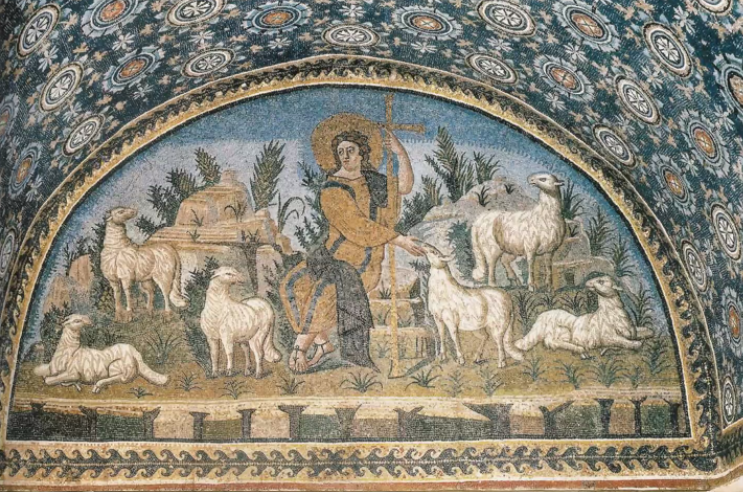
What has changed in Early Christian Art by the time of The Good Shepherd?
Art is now done by multiple skilled professional artists, from amateurish to top-of-the line. The Good Shepherd has become a uniquely Christian image; the end point of syncretism
How does Islam spread so quickly?
Bears familiarity in a variety of cultures. The success of Islamic armies resulted in more territories and caliphates. Early Islam was also tolerant of Christianity and Judaism. The Arabic language served to unify the vast and diverse empire, which meant everyone could read the Qur’an

What does the Dome of the Rock represent in Islam?
Sits on top of a site important to Muslims as well as Christians and Jews. Associated with Abraham and the Temple of Solomon. Marks the location where it is believed the Prophet Muhammad ascended to the presence of God.
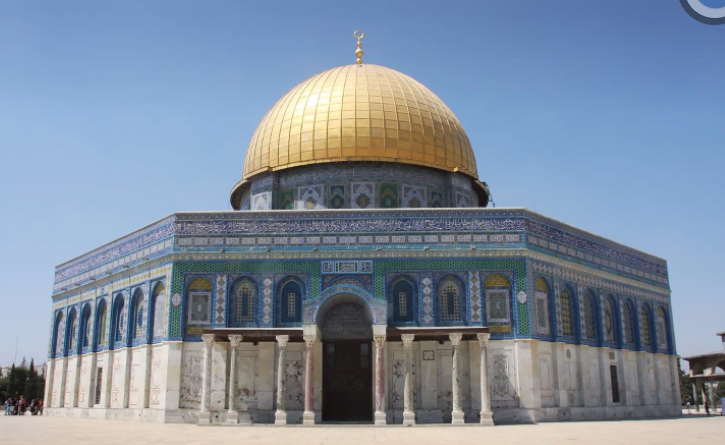
What features of the Dome of the Rock are inspired by other cultures?
Its dome, arches, and Corinthian columns are clearly inspired by Roman buildings. These features are recontextualized here and used to create a spectacular, monumental structure.

What does Dome of the Rock indicate about the state of Islamic culture?
Its rich, expensive decoration is an indication that the portion of the Roman Empire taken over by Islamic rulers was handsomely wealthy. The frieze features a non-representational mosaic with inscriptions of the Qur’an, assuming a literate audience. Islamic art did not typically depict religious figures themselves but, rather, scripture about them. Most of the mosaic work is done by artists with a Byzantine background (Byzantines considered themselves Romans), another indicator of Roman influence
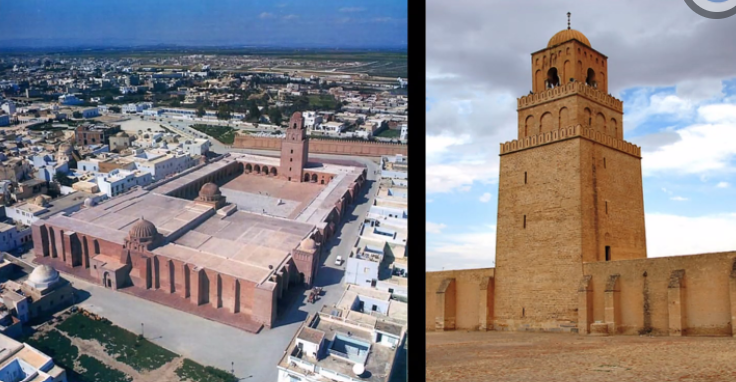
What cultural and religious factors determined the structure of the Islamic Great Mosque?
Because Muhammad would pray with his followers and speak to them, mosques had/have a courtyard, exclusive room for prayer, and a speaking platform. The prayer halls (interior spaces filled with columns) are hypostyle, an element taken from the Classical Period. There is also a distinctive horseshoe arch, which is an example of spoilia from a Christian church adapted after reclaiming territory initially conquered by the Visigoths (barbarian Christians). The cut-out opening in wall (the mihrab) is inspired by Jewish synagogues.
Spoilia
Taking parts of a destroyed, pre-existing building and using them for a new building
Which elements of the Great Mosque are relevant to the broader sphere of Islamic art?
The dome above the mihrab symbolically represents the heavens, a larger insight into the fact that most of Islamic art had some deeper meaning/significance (rarely literal). Illustrated how Islamic mosques were heavily decorated on both the interior and exterior.
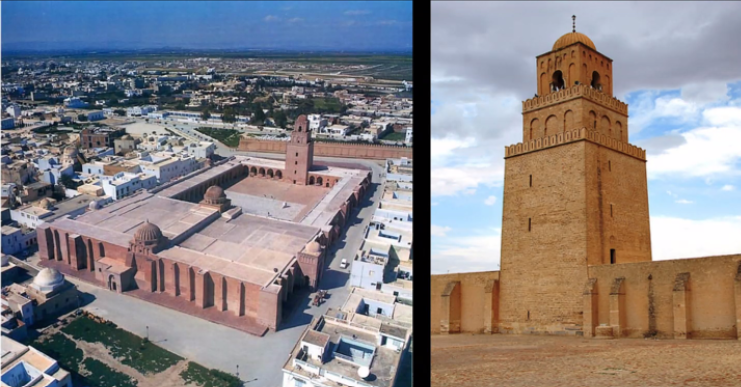
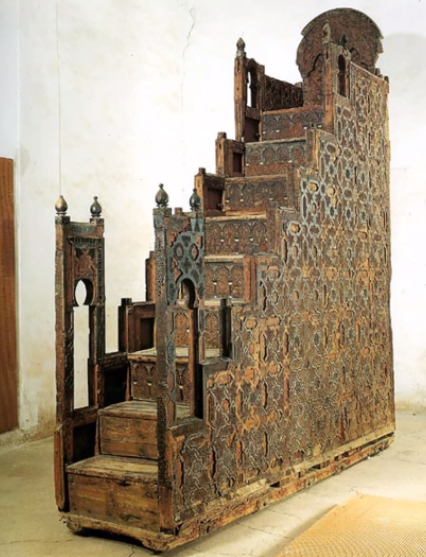
Minbar
A staircase that the Imam would climb upon to deliver his Friday sermon
Strapwork
Interlacing bands of pattern used to create an intricate, eight-sided star look. Meant to mimic some of the decoration on the mosque’s exterior and bring it inside.
Calligraphy’s role in Islamic society
Highly stylized form of writing. Highly esteemed in the Islamic religion, with Calligraphers being among the most respected artists in the empire (debate about figurative art), as they wrote the words of the Qur’an
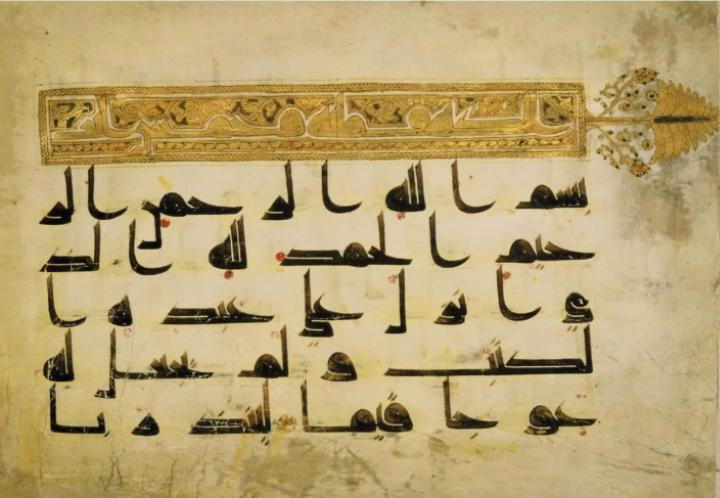
Kufic script
Forceful, block-like letters. Similar to modern-day bold text. Meant to be concise and legible but could also be used decoratively
Significance of text/writing in Islamic society
A variety of fonts were used. Decorative, exquisite fonts were significant, because they took more time to decipher, and the reader would spend more time with God. Generally, passages describing religious figures were used instead of depicting the figures themselves
Lusterware
Complicated process that became a specialty of Islamic potters. To create this luster glaze, you apply a second layer of glaze (which contains traces of metal oxides) after the first firing and fire it again. On the second firing, the oxides are burned away, leaving behind the base metal. Results in a metallic look
Eras of Islamic art
Early Period and Late Period
What is happening in the Islamic Empire by the Late Period? What is its effect on art?
Early caliphates have begun fracturing, and the empire is no longer unified and riddled with internal rifts caused by a number of factors (such as the Sunni and Shia clash and military conflicts with the Mongols. This results in a greater regionalization of Islamic art with no overarching style that all places share. This period is also the beginning of monumental architecture associated with Islam and marks a boom in glassmaking.
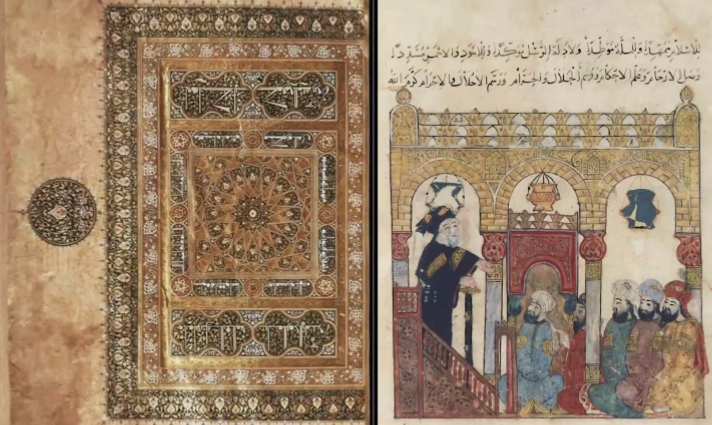
What do the Qur’an Frontispiece (left) and the Maqamat of al Hariri (right) indicate about artistic differences between Islamic caliphates?
The left is more traditional (non-representational with calligraphy and abstract designs) whereas the right is more figurative, illustrating humans and depicting a cautionary tale involving a conman. Human figures were permissible in Iraq, as long as they were fictional and not spiritual or real.
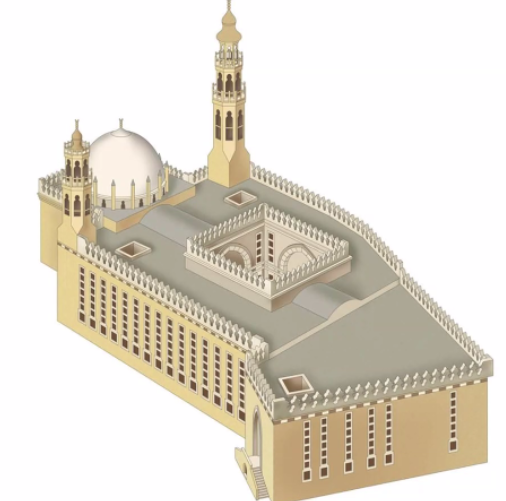
Why would a political figure like Sultan Hasan commission an enormous building like his Madrasa?
Both as a public service, as a symbol of his piety and charity, and to showcase his power and authority
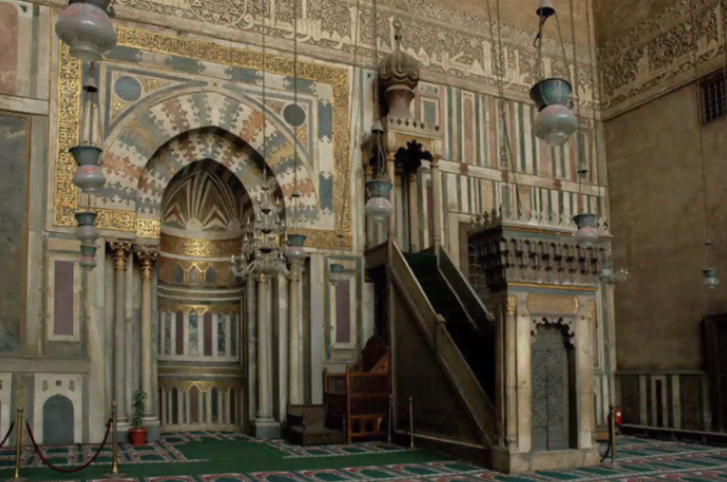
Joggled voussoirs
Puzzle-piece-like decoration
Why did Islamic glasswork experience a boom during the Late Period? How was glasswork used?
The greater numbers of buildings demanded more lamps which required more glassmakers. With the amount of glassmaking increasing, innovation ensued. Glasswork would also be used for decoration inside a mosque (in which case it was commissioned) or export
How did the geographical elements of South and Southeast Asia affect its culture and art?
Culturally diverse with extensive trade routes running through every area, meaning new ideas of religion and art could spread quickly. Extreme climates contributed to agricultural development.
The Indus Valley Civilization
Perhaps the earliest civilization that we have evidence of. New area of historical study; there is little known about their political structure, why they used/engineered certain things, or how they became so proficient with construction (a sudden switch rather than the gradual ones in Ancient Sumeria and Ancient Egypt). Existed at the same time as the Old Kingdom in Egypt and Ancient Sumeria. Flourished along the banks of the Indus River.
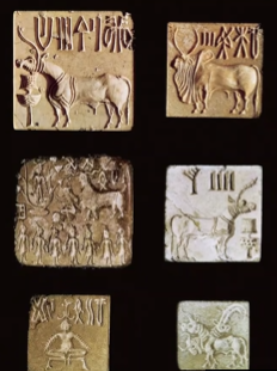
Indus Valley writing
Cannot be translated. Likely a form of pictograph writing blended with a cuneiform-like script.
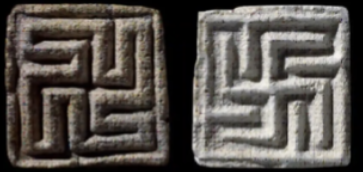
Swastika
An auspicious symbol in Hinduism and Buddhism representing good luck and fortune
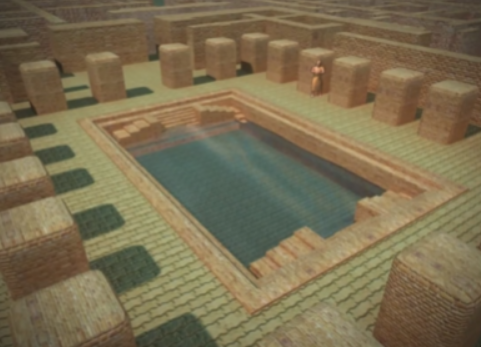
Indus Valley water tanks
May have been used for ritual cleansing/bathing before religious practices (an assumption cast backward from future religious practices), but that is all speculation.
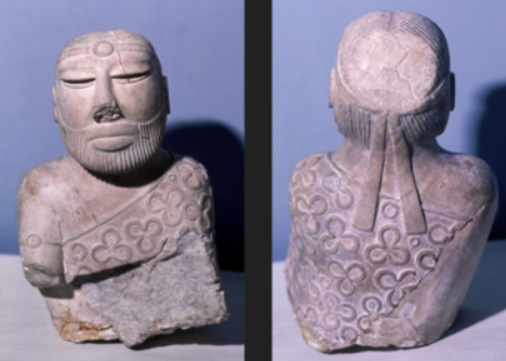
What characterizes Indus Valley sculpture?
Abstract, simplified facial features with more detail paid to the jewelry, headband, and outfit, representing the beginning of a trend that prioritizes the symbols around the subject rather than the subject itself to be recognizable.
What historical trend (beginning in 2000 BCE) would come to shape the recurring themes in South Asian and Chinese cultures, and how?
Starting with the Aryans invading Indus Valley, nomadic people begin periodically invading the South Asian plane, causing brief chaos before being absorbed. Upon their arrival is the first stirrings of Buddhism. Later South Asian history is a product of the fusion of indigenous and nomadic invaders’ cultures.
What is the story of Buddha?
Prince Siddharta lived oblivious to the world’s horrors. When setting out on his own, he is horrified and wonders why there is so much suffering. He meditates and contemplates for a while when nobody can give him a satisfying answer, eventually coming to a realization (Buddha = the enlightened one). The Buddha returns with sermons/teachings that he shares; among these are the Four Noble Truths
Bodhisattvas
In Buddhist religion - people who have achieved enlightenment but delay their entrance into Nirvana to help others do the same
Samsara
In Buddhist religion - the endless cycle of death and rebirth
Nirvana
In Buddhist religion - a state of total enlightenment
How does King Ashoka influence Buddhism and Buddhist art in the Indus Valley area?
Responsible for the first Buddhist-informed art. Maintained control of the empire by teaching people and sharing his ideas/philosophies rooted in Buddhism. Set up various pillars such as a lion capital (which would later become a recurring symbol) that represented his authority/power and taught others. During his reign, Buddhism spread out over India
Dharma
In Buddhism - moral teachings
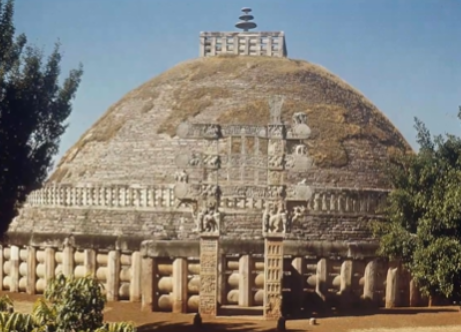
What are Stupas? What were their significance in Buddhism? How were they constructed?
Man-made mounts used to house relics. Became sites of pilgrimage where one would circle it, meditate, and present gifts. The primary form of architecture in South Asia. All of them are designed around the Mandala. Open to the public. Most of it is plain - the exception being the entrance gates on the North, South, East, and West. Constructed on the idea of the Axis Mundi.
Mandala
A map/plan of the universe laid out according to a religious figure. Used to place Buddhist and Hindu temples
Toronas
The entrance gates of a Stupa
Axis Mundi
The idea that there is a line running through the world upon which it rotates
Relics
Objects with some kind of sacred significance, somehow connected to a religious figure (ex. Buddha’s sandals)
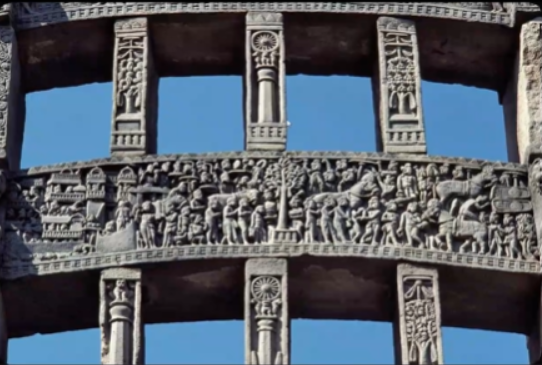
What do these images from the Corona of the Great Stupa depict?
Illustrate a narrative telling a story from Buddha’s life. Buddha is only shown through footprints and is symbolically present through his absence: he is there, because he is not there.
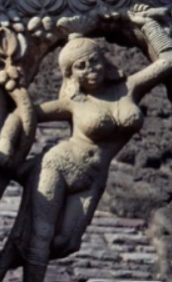
Yachi figures
Nude female figures that represent fertility and abundance
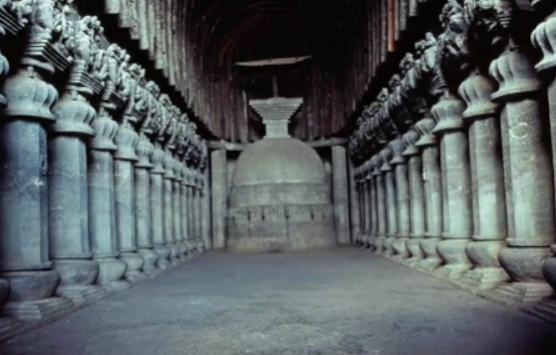
What is the Chaitya Hall?
A rock-cut temple mostly used for monastic communities (monks who have committed to studying Buddhist teachings).
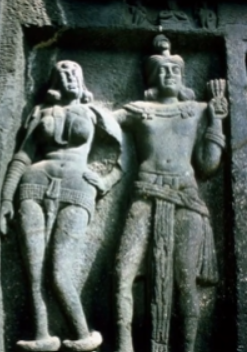
What does this couple from the Chaitya Hall symbolically represent?
They signify the notion of balance and harmony present in all facets of life. The union of a man and a woman is the balance of opposing forces brought together. Here, nudity does not have the same connotations as it does in the West
What happens with the arrival of the Kushan period? How does this affect Buddhist art?
The Kushan leaders, who were nomadic invaders, were religiously tolerant and supportive of the arts (which they financially supported). Under their leadership, the first figurative representations of Buddha are born.

Gandhara style
Defined by blend of native and indigenous aesthetics with external influences beyond India (particularly Hellenistic, representing a clear connection between the East and West as a result of Alexander the Great’s conquest). Later dies out
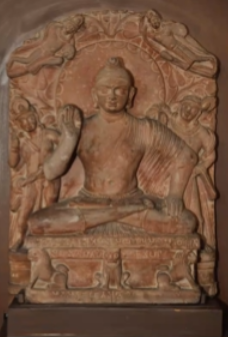
Mathura style
Wholly indigenous to the Indian subcontinent with no external influences. Known for its use of symbolism. Highly stylized and decorative. Later Buddhist art draws most of its influence from this style. Use particular hand gestures (Mudras) that are associated with specific teachings
Lakshanas
Physical markings that indicate the Buddha, such as the Urna (mark between the eyes), Ushnisha (distinctive hairstyle), elongated earlobes, and markings on the soles of the feet. Use the same, earlier developed idea of giving greater emphasis to clothing and accessories rather than the face
Gupta period
Although short-lived, it hosted the first instance of monumental architecture that was associated with Hinduism
What is remarkable about Hinduism’s development compared to other religions at the time? How does this impact art concerning it?
The earliest beliefs of Hinduism predate the Gupta period as well as Buddhism and all other existing religions at the time, stretching back to the Neolithic and perhaps the Paleolithic periods. For years, it is spread only through oral traditions. It is relatively late in its development (beginning in the Gupta period) that its central texts are written down and it becomes a formal, recognizable religious system.
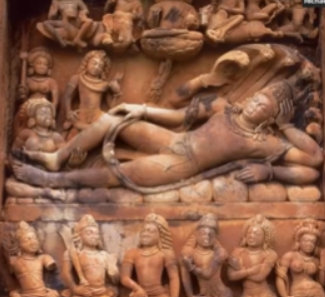
What does the relief on the Vishnu temple depict? What does this indicate about Hinduism? What trend is continuing here?
The large figure is Vishnu dreaming the world into existence. Surrounding him is a multi-headed snake, Avanta, and his consort, Lakshmi. The bottom shows multiple avatars of Vishnu, Rama, Krishna. This suggests that there is one large figure that can be divided into three with different aspects that each have a deity associated with it. Because Hinduism argues there is one spirit from which everything stems, it is arguably monotheistic. The relief relies heavily on symbolism with figures who are, once again, identifiable through their clothing and body positions (carried over from Buddhist art)
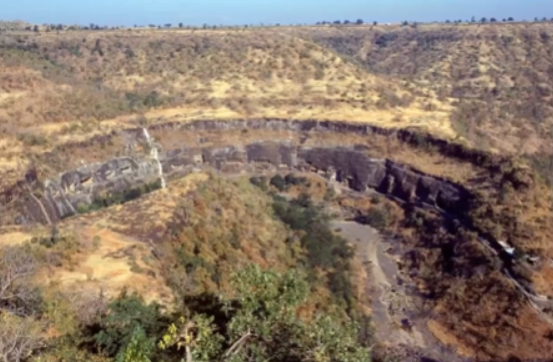
Ajanta Caves
One of the greatest examples of Buddhist art, with interiors hosting numerous halls with their famous paintings. Used as a monastic community
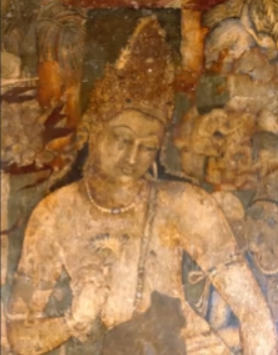
What is the cultural and religious context concerning this painting of a Bodhisattva? What is the style/appearance of this painting along with other Buddhist paintings?
Each Buddhist cave had a patron who paid for the artistic program. As Buddhism expanded beyond the Indian sub-continent, Bodhisattvas take on a greater role. Emphasizes a languid, smooth style reminiscent of Hindu deities. Once again, the trend of particular jewelry, crowns, and bags makes an appearance, as the viewer has to rely on those and the figures surrounding the subject to determine the identity of the Bodhisattva
What changes in Hindu art with the Pahlavi period?
An increasing complexity in design: more figures and more symbols
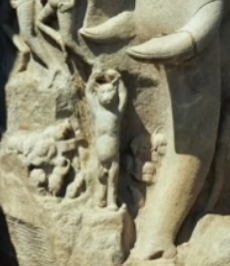
Yogic posture??
Used in the decorative scene of the Descent of the Ganges. Indicates calmness and harmoniousness. Satirically, a cat engages in this to lure mice into thinking it is a safe cat. A cautionary tale to not trust appearances
What happened during the Chola Period? What did it mean for the future of Hindu art?
When Cholas ruled South Asia. Represents the beginning of vast cultural differences between South and North Asia. During this period is the rise of the worship of the Hindu god Shiva. Cholan rulers’ wealth triggered great leap forwards in art, which explained why, once Hinduism broke out in India, it is in a South Indian style
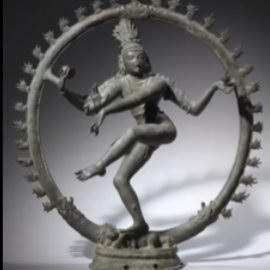
Shiva
The lord of dance. In Hinduism, he danced the universe into being and metaphorically enacts the cyclical creation and destruction of life. Through his dance, he represents the constant circle of life into death
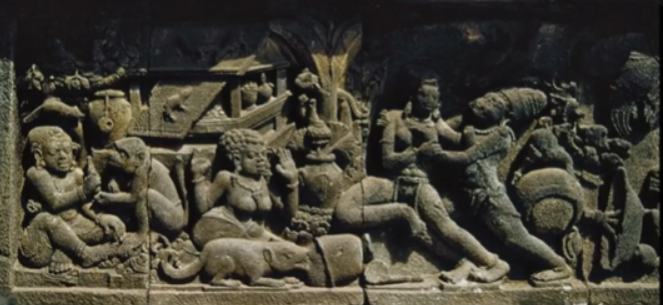
What is the story behind the Abduction of Sita? What does this relief indicate about how Hinduism is handled once it leaves India?
Depicting an episode from the Ramayana text. Sita, the consort, is abducted by Ravana, and Rama leads a military expedition to get her back. This is a blending of a story from a South Asian tradition into an Indonesian scene, with a traditional Indonesian town and figures dressed like contemporary Indonesians, Indonesian jewelry, etc. Much of the theology of Hinduism stays the same, but local artists often add their own spin on the texts to make them relatable to their local audience
How does Ancient Chinese and Korean geography impact the spread of culture?
The emphasis of trade such as the Silk Road connected China to the West, a route where religious and artistic ideas could spread
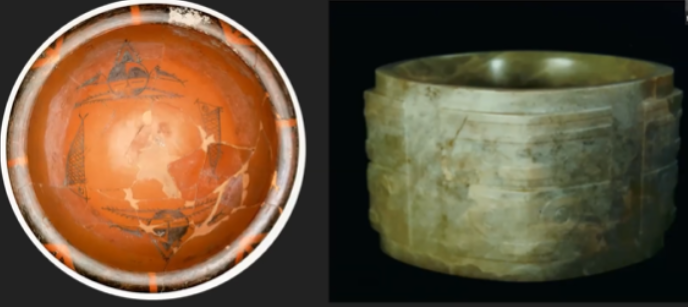
What characterized Chinese ceramics in the Neolithic period?
Boasted an incredible level of sophistication and often expressed philosophical ideas in a balance between natural representation and the abstract.
What agricultural and societal developments allowed for more sophisticated ceramics and metalwork in Ancient China?
Development of rice and millet farming which created advanced kilns. Development of large-scale cities based around agriculture.
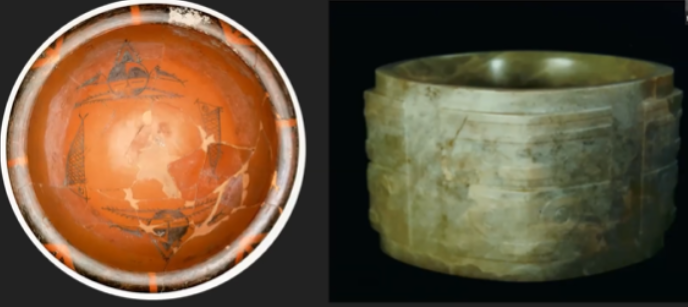
How did the Liangzhu society create these out of Jade, an extremely hard rock?
Most likely used sand to smooth/carve it
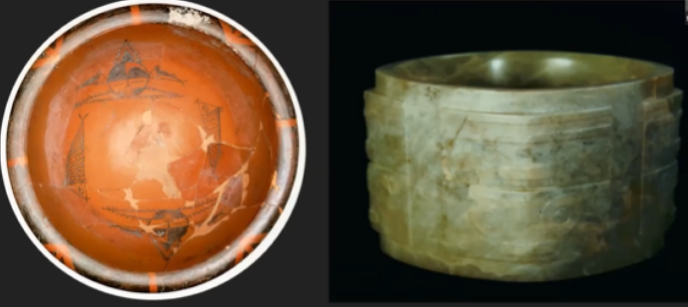
What were the importance of these ceramics in Ancient Chinese society? What were they most likely used for?
Unclear whether the design is just for aesthetics or whether it is trying to communicate an idea. On the left, there are two human faces and two fish in an abstract style in contrast with the sophisticated ceramic work. There is no evidence of anything being stored inside these
Describe the political state of China during the Bronze Age
Not really an empire and instead a patchwork of competing cities and territories; not unified. The Shang “Dynasty” is considered the first dynasty of China we have solid evidence of. Though it is called a dynasty, the Shang Dynasty was not controlled by a family. Instead, the Shang’s were affluent with elaborate tombs and burial practices. The notion that political authority is bound up with a set of rituals and rules is born here
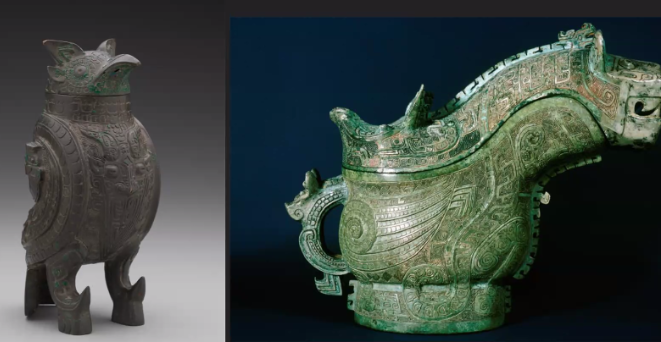
What were the significance of these Ancient Chinese bronzes, Guangs?
These were ritual bronzes likely used for libations, where liquids (likely wine) were ceremonially poured out. They were primarily found in tombs. It is unclear whether they were used as part of the burial or meant to be used in the afterlife by the deceased
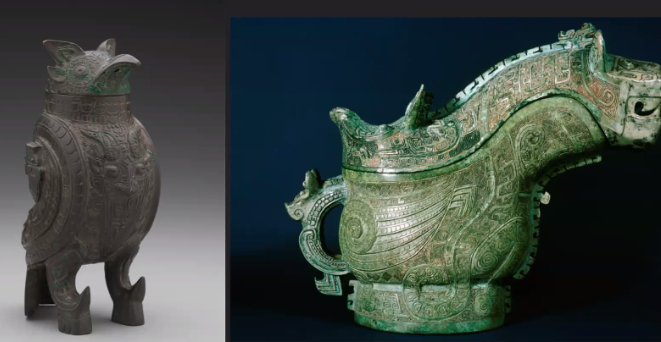
How were these ritual bronzes made?
Piece-mold casting, where the vessel is created in pieces and then assembled, which allowed for very detailed decoration
What idea concerning leadership and political power is born with the Zhou Dynasty?
Royalty is now associated with divine favor; leadership and political power comes from divine appointment. Though the ruler/elite itself isn’t divine, they are elite because of divine favor
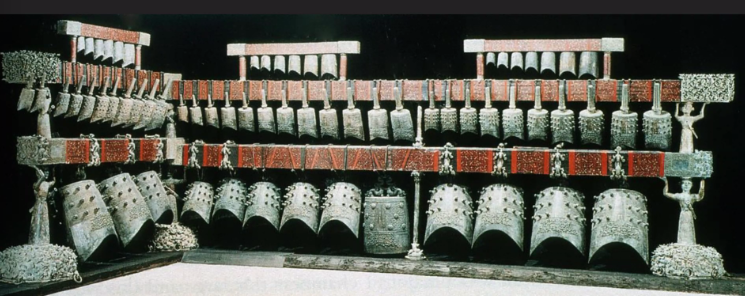
What is unique about these bells found in the tomb of Marquis Yi?
They are fully-functional, but it is unclear whether they were meant to be played during funerary rites or used in the afterlife
How did Emperor Shihuangdi, the first Chinese emperor, rule China during the Qing Dynasty?
Being the first who managed to unify China under one leader, he ruled China sternly (perhaps ruthlessly), believing the best way to hold a diverse empire together was strict, decisive, administrative rule
What does the tomb of Emperor Shihuangdi suggest about emperors’ views of the afterlife? What culture is this similar to?
The Mausoleum’s scale and attention to detail would have taken the emperor’s lifetime to develop, so it is likely that he began constructing it as soon as he seized control in a similar manner to how pharaohs prepared their tombs during their rule in Old Kingdom Egypt
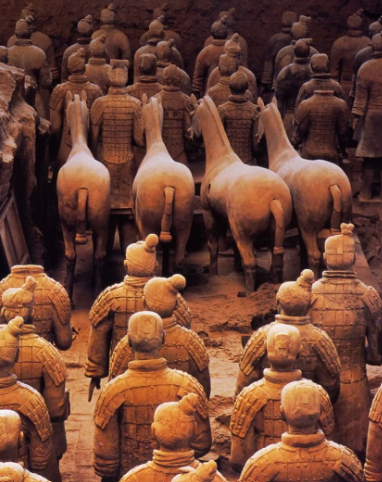
What is inside the Mausoleum of Emperor Shihuangdi?
Hundreds of life-sized soldiers each distinct from one another
How did the Han Dynasty set the stage for future dynasties?
Opened the Silk Road. Future dynasties looked back on the Han Dynasty as a model for their own culture. When Daoism became increasingly popular
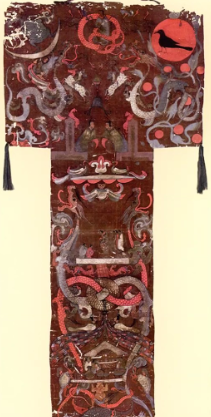
What does the Painted Banner from the tomb of Marquess Dai suggest about religion in the Han Dynasty? What are its contents?
Illustrates a noble woman’s journey through the afterlife. Indicates that the dynasty’s spiritual beliefs could not be fully classified as a religion. It was “unorganized” in the sense that nobody wrote down the specifics of spiritual beliefs
What does this Incense Burner represent in Chinese culture?
Represents an obsession of Daoist followers: the search for immortality. Illustrates the land of the immortals. Overall feel is of water/liquid, a central element in Daoist philosophy: even a gentle drip could wear down a mountain over time
What is the significance of Daoism in Ancient China?
A highly individualized philosophy rather than a religion. Dao translates as “the way; the path.” A path that is a return to nature. The goal of Daoism is to live in harmony with the natural world
What cultural unrest preceded and characterized the “Six Dynasties Period?” What art form rises in popularity?
Followed the fall of the Han Dynasty. A period of chaos involving short-lived kingdoms. Upheaval and unrest. Painting rises in popularity
Qi
Coined by intellectuals. Refers to the inner spirit/soul of a painting as visualized in its brush strokes. Complicated theoretical idea
What is an hand scroll? What is its significance in Chinese culture?
Scroll of silk with ink writing and pictures. The idea is to unroll the whole thing at once but to instead unroll one section at a time
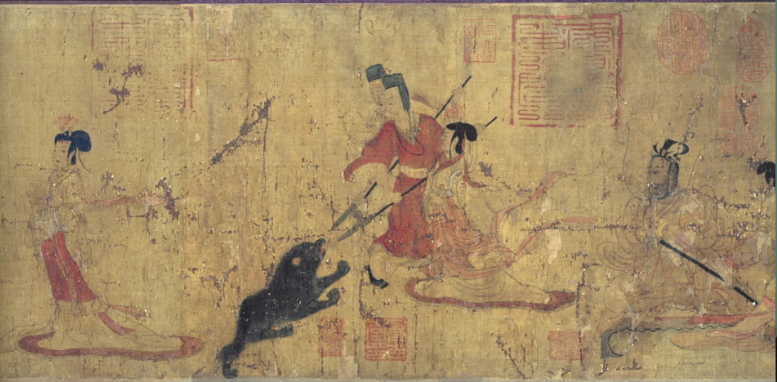
What is the narrative told in this hand scroll, Admonitions of the Imperial Instructress? What is its cultural relevance to Ancient China?
Informs a court lady how to behave as a wife. Tells the story of one of the emperor’s wives who sacrifices herself after he is attacked by a circus bear. Indicates that, to be wifely, your duty is to sacrifice yourself for the more important person, the emperor, an idea tied to Confucian philosophy
What is the cultural relevance of Confucianism?
The original writings of the scholar Confucius are ancient and have ties back to the Shang Dynasty. Confucianism emphasized the idea of obligations, duties, and responsibilities
What happens culturally during the Northern Wei and Sui Dynasties?
Buddhism moves out of India, along the Silk Road, and into the way into China. It is widely appealing, as it does not discriminate based upon one’s family or place of birth. Led to the rise in popularity of Mahayana Buddhism once it reached China
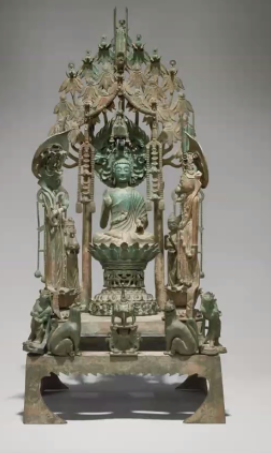
What characterizes Mahayana (“Pure Land”) Buddhism?
Mixes up with other things, leading to Zen Buddhism. Emphasizes compassion toward all things. Serenity, balance, and harmony. Living with compassion for all things is a way to release oneself from Samsara
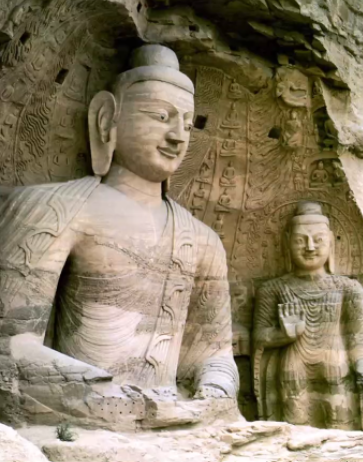
What elements of the Seated Buddha are consistent with Buddhism? What is the historical context of this statue’s creation?
Though clearly modeled on Silk Road Buddhas, still has standard Buddhist iconography: hand gestures, elongated ears, top knot, etc.
What were the political and cultural effects of the Tang Dynasty’s reign?
Considered one of the most culturally important Chinese dynasties. Managed to unify the Chinese Empire. Incurred a political movement that implemented consistent culture across the empire - particularly a uniform architectural style regardless of the type of building that was being built. Emphasized key ideas of simplicity, gracefulness, and balance. Curved/swooping roofline. So influential that it shaped all later architecture in the Chinese empire

What was the state of Tang Dynasty paintings? What does it indicate about how art was seen, and how does that differ with the modern Western interpretation of art?
Although painting was widespread, there are no originals - only later copies. These copies were exact replications. Being able to capture the style of a master artist was highly-regarded as a manifestation of Confucian ideas regarding reverence for ancestors, displaying technical mastery and interest in earlier art. Since romanticism, Western art has emphasized that art must be original and embrace the unique identity of the artist, but this idea was not always true and is not true everywhere

What were these created for? What do these earthenwares indicate about Tang Dynasty art? What connections do they have to the Silk Road?
Created for royal tombs. Emphasis on refinement, a characteristic of Tang Dynasty art. Both are Silk Road images, as horses were introduced to China through the Silk Road, leading to the rise in popularity of horseback riding among Tang elites. Camels, also a Silk Road animal, carry foreigners. Indicates that the Tang Dynasty was open to the outside world
What preceded the Song Dynasty? What are the cultural differences among the empire?
Preceded by the Tang Dynasty’s fall to chaos. The Song Dynasty then splits into a Northern and Southern portion. The “Northern Song Dynasty” falls to the influence of invaders. The original Song Dynasty controlled by Native Chinese people moves to the South (“The Southern Song Dynasty”). North is outsiders, and South is a continuation of the native Chinese
Art of the Northern Song Dynasty
Origin of the hand scroll and hanging scroll. Characterized by landscape paintings and emphasis on nature

What is the artistic and cultural significance of the Travelers Among Mountains and Streams? How does it inform other Chinese paintings of landscape?
Considered one of the greatest masteries of hanging scroll painting, especially naturalistic landscape things. Most recognizable Chinese paintings. These landscapes are a product of the Song Dynasty

How does the composition and format of Song Dynasty landscape paintings impact the viewer’s experience?
Because there is no fixed viewpoint, no area demands the focus of the viewer. Instead, the painting allows the viewer’s eye to wander and lets them mentally project themselves into the natural landscape, mimicking the feeling of seeing it in-person. Each person’s viewing highly personalized. Hand scroll paintings in particular were intended to be seen bit by bit, imitating the idea of hearing a song compose itself

What is unique about this hand scroll, a section of Spring Festival on the River, compared to other paintings of landscapes?
Unlike other paintings that assumed and expected multiple viewers from different backgrounds, this hand scroll was created specifically for Emperor Huizong. Not personalized; the emperor was meant to use this as a documentary of activities going on in his empire. Depicts a real place instead of an imagined natural environment - less of a creative act compared to other paintings

What is Guan Ware?
One of the most prized styles of ceramics. Elegant and slim. Minimalistic stoneware that has an ethereal, grayish blue-green glaze applied to it

What was Early Japan’s relationship with outside influences? What is its impact on art?
Initially open to outside influence in mainland Asia, especially China. Beginning after the 9th century CE, Japan cut its ties to the outside world and became increasingly insular. This isolationism will have a great impact on art. Ideas still made it over, but they took on a uniquely Japanese expression